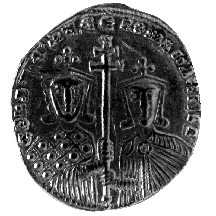



(145) Constantine VII and Romanus II - AV solidus, A.D. 945-959,
4.37 g. (inv. 91.288).
Obverse: Facing bust of Christ with cross-nimbus, r. raised in blessing,
l. holding book: IhS(VS) XP(ISTO)S REX REGNANTIVM: Jesus Christ, King of
those who rule.
Reverse: Facing busts of Constantine l., wearing loros and crown
with cross, and Romanus r., wearing chlamys and crown with cross,
both holding patriarchal cross between them; CONSTANT(INVS) CE ROMAN(VS)
AVGG (AVGVSTI abbreviated) B(ASILEIS) R(OMAION): Constantine and Romanus,
Augusti, kings of the Romans.
Provenance: Edward Gans, 1959.
Bibliography: W. Wroth, Catalogue of the Imperial Byzantine Coins in
the British Museum (London 1908) 465.60; P. Grierson, Byzantine Coins
(London 1982).
Constantine VII Porphyrogenitus spent more than thirty years on the throne
before he was able to take power from his regents in A.D. 945; shortly afterward
he made his son, Romanus II, co-emperor. Like his father, Leo VI, Constantine
was a scholar, and he is best known not for his political or military exploits
but for his encyclopedic scholarship and patronage of intellectual pursuits.
This coin revives the bust of Christ Pantokrator, or Christ as the ruler
of the universe, which had been introduced on some coins of Justinian II
and which would be the main type on Byzantine coins for the next one hundred
years.
Constantine and Romanus appear in the conventional imperial portrait on
the reverse, with Constantine designated senior emperor by his position
on the left, by his more elaborate dress, and by his slightly larger scale.
E.N.J.



All contents copyright (c) 1996.
Lawrence University
All rights reserved.